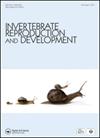双酚A对砂圆蚧幼虫形态及存活的影响
IF 0.7
4区 生物学
Q4 REPRODUCTIVE BIOLOGY
引用次数: 1
摘要
双酚a (BPA)是一种用于苯酚树脂、环氧树脂、聚酯和聚碳酸酯塑料的原料。BPA通过有毒废物处理、地下水、污水径流和塑料浸出释放到水生环境中。当双酚a进入水生环境时,会影响海洋生物的发育和生理。本研究旨在了解相对低浓度双酚a (BPA)对沙棘树突幼虫的影响。将胚胎和幼虫分别暴露于4种处理溶液(无添加剂、对照、50µg/L BPA和500µg/L BPA)中7天。这两种双酚a处理浓度高于通常在沿海海水中检测到的浓度,但低于大多数其他关于双酚a对棘皮动物发育影响的研究中使用的浓度。暴露后测定幼虫中线体长、后臂长、正常发育次数和存活率。在BPA的存在下,中线体长、正常发育频率和存活率均呈剂量依赖性下降。因此,相对低浓度的双酚a对沙美元幼虫的发育有很强的影响。本文章由计算机程序翻译,如有差异,请以英文原文为准。
Effects of Bisphenol-A on the morphology and survival of larvae of the sand dollar Dendraster excentricus (Echinodermata, Echinoidea)
ABSTRACT Bisphenol-A (BPA) is an ingredient used in phenol resins, epoxy resins, polyesters and polycarbonate plastics. BPA gets released into the aquatic environment through toxic waste disposal, groundwater, sewage runoff and plastic leaching. When BPA enters aquatic environments, it can affect the development and physiology of marine organisms. This study aimed to understand the effects of relatively low concentrations of BPA on the larvae of the sand dollar Dendraster excentricus. Embryos and larvae were exposed to four treatment solutions (no additives, vehicle control, 50 µg/L BPA, and 500 µg/L BPA) for 7 days. The two BPA treatment concentrations were higher than have usually been detected in coastal marine waters, but lower than those used in most other studies of BPA effects on echinoderm development. After exposure, larval midline body length, postoral arm length, frequency of normal development and survyivorship were measured. Midline body length, frequency of normal development and survivorship all decreased in the presence of BPA, in a dose-dependent manner. Relatively low concentrations of BPA can thus have strong effects on the development of sand dollar larvae.
求助全文
通过发布文献求助,成功后即可免费获取论文全文。
去求助
来源期刊
CiteScore
1.90
自引率
0.00%
发文量
21
审稿时长
>12 weeks
期刊介绍:
Invertebrate Reproduction & Development ( IRD) presents original research on the reproductive and developmental biology of the Invertebrata, both embryonic and postembryonic. IRD welcomes papers reporting significant results obtained using new techniques. Encouraged topic areas include: aquaculture, physiology, biochemistry, functional morphology, phylogeny, behavioural and regulatory mechanisms, including genetic, endocrine and molecular studies. Papers containing qualitative descriptions of reproductive cycles and gametogenesis will not be considered. IRD is published in association with the International Society of Invertebrate Reproduction and Development.

 求助内容:
求助内容: 应助结果提醒方式:
应助结果提醒方式:


